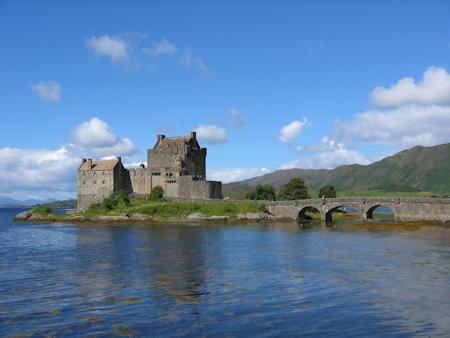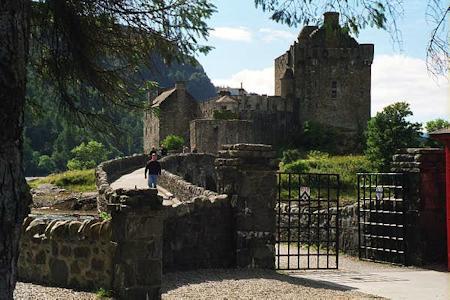
Eilean Donan Castle
Eilean Donan Castle is one of the most photographed castles in Scotland. It's the one that features on the shortbread tins, calendars and tourist board videos. The castle sits on a tidal island at the edge of Loch Duich and the site has been occupied since the Iron Age.
The early castle was very different to the romanticised 20th Century structure we see today.
Early History
There is some evidence that the island of Eilean Donan has been occupied since the Iron Age. The island and castle take their name from Saint Donnan of Eigg, who was martyred on Eigg in the early 7th Century.
The first castle on this site dates from the mid-13th Century. The enclosure went right round most of the island at this point. Access was via a sea-gate on the north-western side.
At this time Eilean Donan Castle was at a strategic location on the border between the Kingdom of Scotland and the Viking/Gaelic Lords of the Isles.
King Alexander III of Scotland gave Eilean Donan castle to the MacKenzie clan. The MacKenzie claim to Eilean Donan was disputed by the William, 1st Earl of Ross, who thought that the castle belonged to him under the Treaty of Perth. This began almost a century of feuding between the Earls of Ross and the MacKenzies over the island.
According to MacKenzie clan tradition they sided with Robert the Bruce during the Scottish Wars of Independence. Eilean Donan was never assaulted during the conflict, but it is said that Robert the Bruce stayed here in 1306 after his defeat at Dail Righ.
There is no contemporary evidence that Robert I was at Eilean Donan, but it is telling that his son David II granted a charter to the MacKenzies confirming their ownership of the castle and its estates very quickly after his return from exile in 1362.
Clan Macrae
During the early 14th Century the Macrae Clan had been gradually moving into the area around Kintail. They were friendly with the MacKenzies and the Macraes were made castellans for Eilean Donan Castle and bodyguards to the MacKenzie clan.
The Macraes were fearsome warriors. They soon acquired the nickname "MacKenzie's coat of mail".
At some point in the late 14th Century or early 15th Century Eilean Donan Castle was rearranged. No one is quite sure why (or quite when), but the large outer wall around the island was abandoned in favour of a much smaller castle layout on the south-western side of the island. No doubt this made the castle easier to defend.
In the early 15th Century King James I had decided to pacify the Highlands and reign in the power of MacDonald Lords of the Isles. The MacKenzie clan supported him.
In 1488 the MacKenzies and the Macraes took part in the Battle of the Park near Strathpeffer against the MacDonalds. During the battle, Big Duncan of the Axe killed the MacDonald champion Lachlan Maclean of Lochbuy. After that the Macraes at Eilean Donan has to repel several MacDonald raiding parties and a few attacks by sea.
In the late 16th Century Eilean Donan Castle was extended again. An elaborate bastion was constructed on the east side of the castle to defend the main entrance. It probably served as an artillery position and it was defended with a bridge and strong iron yett.
During the Wars of the Three Kingdoms the MacKenzies sided with Charles I. The area around Eilean Donan was Royalist all through the conflict. Even when the Scottish Parliament ordered Eilean Donan Castle to be garrisoned the local populace drove them off. In June of 1654 General Monck marched through Kintail destroying property as he went.
Jacobite Uprising and Destruction
During the Jacobite Uprising in 1715 the MacKenzies were on the Jacobite side. William MacKenzie, 5th Earl of Seaforth, led men from Clan MacKenzie and Clan Macrae from Eilean Donan to the Battle of Sheriffmuir.
The uprising failed, but the Jacobites had secured support from Spain. In 1719 a Spanish fleet arrived in Loch Duich and garrisoned the castle. The expected uprising of the Highlanders never happened and Spanish reinforcements never arrived. In May three frigates from the Royal Navy arrived and pounded the castle for three days, all but demolishing it.
Eilean Donan Castle was abandoned after this and it remained a ruin until it was bought by Lt. Col. John MacRae-Gilstrap. Between 1919 and 1932 he undertook and extensive renovation and impressive reconstruction programme. He followed the ground plan of the medieval castle, but many of the details differ from its original construction.
Today the castle is entered from the south, complete with a modern gatehouse and portcullis. The keep is its original size, but some of its internal rooms have been rearranged.
Eilean Donan Castle is open to the public as a tourist attraction. You can tour almost every part of the castle and guides are on hand to explain this history and exhibits.
Other facilities available at the castle include a visitors' centre with a coffee shop and toilets. The castle can also cater for group visits. The castle also offers a range of wedding services and a cottage is available for hire on the estate.
Eilean Donan Castle is one of the most photogenic castles in Scotland. Its image has appeared on shortbread tins, postcards and all manner of tourist souvenirs. It has also featured in a number of tourist board videos and advertisements as well as fashion shoots and music videos. It has appeared in films a number of times including the James Bond film "The World is Not Enough" where it was the headquarters for MI6, and the 1986 film "Highlander".
Status: Visitor Attraction
Owner: Conchra Charitable Trust
Tel: +44 (0)1599 555 202
Email: eileandonan@btconnect.com
Website: www.eileandonancastle.com
Opening Times: Feb to 27th Oct Daily 10am-6pm / 28th Oct to 30th Dec Daily 10am-4pm


Looking across the water at Eilean Donan Castle

View over the bridge to the castle